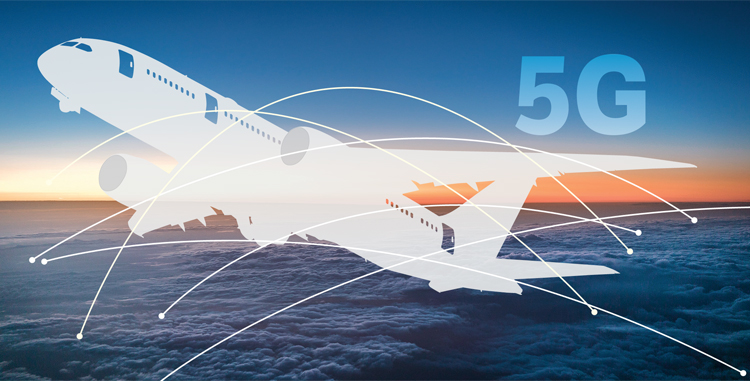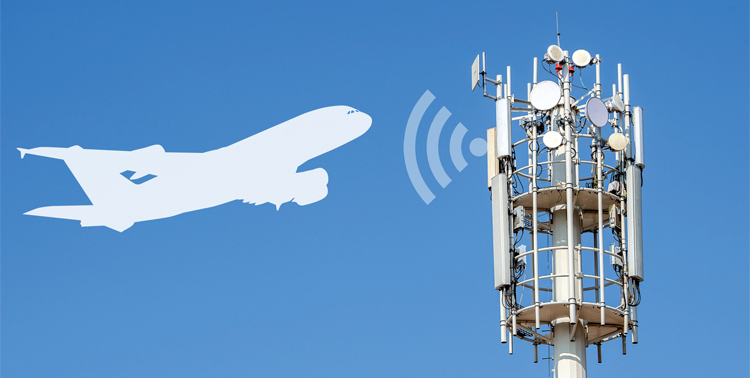FAA, 5G & Aviation Safety in the US
FAA clears an estimated 90 per cent of the US commercial aircraft fleet for most low-visibility approaches in 5G deployment

The concerns over 5G services rollout have been making rounds for some time now in the aviation industry. Delays and cancellations also surfaced recently among major airlines across the globe due to the 5G C-band deployment. Airlines like British Airways, Emirates, Japan Airlines, Lufthansa, All Nippon Airways and Air India cancelled some flights to the United States (US) in lieu of the warning that the 5G networks might interfere with the in-flight instruments. US’ Federal Aviation Administration (FAA) has also been vary about the same. However, recently a set-up was established by FAA in coordination with the telecom companies to ensure safety.
FAA Administrator, Stephen M. Dickson released the statement informing, “We established a direct relationship with the wireless companies to receive the necessary information—transmitter location, power level and signal shape characteristics—to begin making an aviation safety assessment.” He further added that the wireless companies also agreed to keep towers turned off around airports that have low-visibility approaches. The safety model developed—along with the new data accessed from the telecommunications companies—allowed the FAA to determine which combination of altimeters and aircraft could be cleared to land in low-visibility conditions for specific runways at airports with 5G towers nearby.

On January 19, 2022, the wireless companies, Verizon, and AT&T activated 5G C Band service in many of the 46 markets in the US. “Our analysis of the wireless company data has allowed us to target anticipated problem areas more precisely, reducing the impact to both industries. While we have avoided significant disruption to commercial aviation, we recognise that some communities and operations have been affected because we have not been able to fully mitigate interference risk for certain radio altimeters,” stated Dickson. The radio altimeters in the aircraft measure the height of the airplane from the ground and essentially assist in landing.
Towards the end of January the FAA, Verizon, and AT&T agreed on steps that will enable more aircraft to safely use key airports while also enabling more towers to deploy 5G service. Technical collaboration was done on precisely noting the exact location of wireless transmitters and carry thorough analysis of how 5G C-band signals interact with sensitive aircraft instruments. The FAA used data to determine the possibility to safely and more precisely map the size and shape of the areas around airports where 5G signals are mitigated, reducing the areas where wireless operators are deferring their antenna activations. “This will enable the wireless providers to safely turn on more towers as they deploy new 5G service in major markets across the United States. The FAA continues to work with helicopter operators and others in the aviation community to ensure they can safely operate in areas of current and planned 5G deployment,” the administration stated.
On January 19, 2022, the wireless companies, Verizon, and AT&T activated 5G C Band service in many of the 46 markets
The FAA also issued an Airworthiness Directive (AD) revising the landing requirements for Boeing 737 MAX airplanes at airports where 5G interference could occur. The agency also gave clearance to an estimated 90 per cent of the US commercial aircraft fleet, including the Boeing 737 MAX, for most lowvisibility approaches in 5G deployment. This AD will not apply to landings at airports where the FAA determined the aircraft radio altimeters are safe and reliable in the 5G C-band environment. FAA specified, it also does not apply to airports where 5G isn’t deployed. The FAA issued the AD because many systems on 737 MAX rely on the radio altimeter, including autothrottle, ground proximity warning, thrust reversers and Traffic Collision Avoidance System. The AD applies to approximately 177 airplanes in the US and 657 worldwide. Up until January 16, 2022 the FAA had only cleared an estimated 45 per cent of the US commercial fleet. The FAA also approved 20 altimeters which is how about 90 per cent of the US commercial fleet can perform low-visibility landings at most airports in the 5G deployment. The FAA anticipates that some altimeters will have to be retrofitted or replaced.
The FAA underlined that as of January 5, 2022, none of the 88 airports would have been available for landing during low-visibility condition. However, the wireless companies agreed to create buffer zones for six months around airports where transmitters are in close proximity.

“We recognize the economic importance of expanding 5G, and we appreciate the wireless companies working with us to protect the flying public and the country’s supply chain. The complex US airspace leads the world in safety because of our high standards for aviation, and we will maintain this commitment as wireless companies deploy 5G,” said US Transportation Secretary Pete Buttigieg.
The FAA continues to work with the aviation industry and wireless companies to try to limit 5G-related flight delays and cancellations. A list of 50 airports that will have buffer zones was released by the FAA. The FAA ensured that the wireless companies agreed to turn off transmitters and make other adjustments near these airports for six months to minimise potential 5G interference with sensitive aircraft instruments used in low-visibility landings.
Once the rollout was rolled out in the US by the FAA, the disturbance was relieved in the US-bound air travel as the flights resumed.
HISTORY OF THE FAA-5G STORY
Since 2015, the FAA and the world aviation industry jointly raised concerns both industries would need to address to achieve similar results and had ongoing technical discussions. In the World Radio Conference proposal, the proposal only supported an international mobile telecommunications (IMT—i.e., 5G) allocation in the 3.4 to 3.7 GHz spectrum—not the 3.7 to 3.98 GHz spectrum that is the issue for radio altimeters.
In 2018, Boeing raised concerns and proposed a solution. Additionally, ICAO (International Civil Aviation Organisation) identified that any use of the bands near 4.2 to 4.4 GHz should be contingent upon Radio Altimeter Studies. In the same year, the Air Line Pilots Association raised concerns. In 2020 ahead of the auction for 5G C-Band, the FAA again raised concerns and asked for a postponement to collaborate on a solution. Throughout 2021, the aviation industry continued to ask for additional collaboration and time in anticipation of the complications being faced. The industry also held several meetings throughout the year to find solutions, including in June and October.
The wireless companies agreed to create buffer zones for six months around airports where transmitters are in close proximity
The 5G services in the US were launched using frequencies in a radio spectrum called the C-band. These frequencies can be close to those used by radio altimeters, an important piece of safety equipment in aircraft. To make sure that this does not lead to hazardous interference, the FAA required that radio altimeters are accurate and reliable. Because the proposed 5G deployment involves a new combination of power levels, frequencies, proximity to flight operations, and other factors, the FAA must impose restrictions on flight operations using certain types of radio altimeter equipment close to antennas in 5G networks. Since the frequencies used by the telecom companies are so close to the frequencies used by onboard instruments such as radar altimeters, which operate in the 4.2-4.4 GHz range, there are higher chances of interference in the signals, and lack in the accuracy of data, which can further be accidental. The 5G service has been a cause of concern for aviation in other regions of the world too, the situation is critical in the US which auctioned 5G bandwidth in 2021 in the 3.7-3.98 GHz on the C-band spectrum range. “5G and aviation have safely coexisted in other countries because power levels have been reduced around airports and the industries have worked together prior to deployment. For years, we have been working to find a solution in the United States,” stated the federal agency. The FAA is continuing its work towards reducing effects of this disruption while progressing to safely integrate 5G and aviation.





